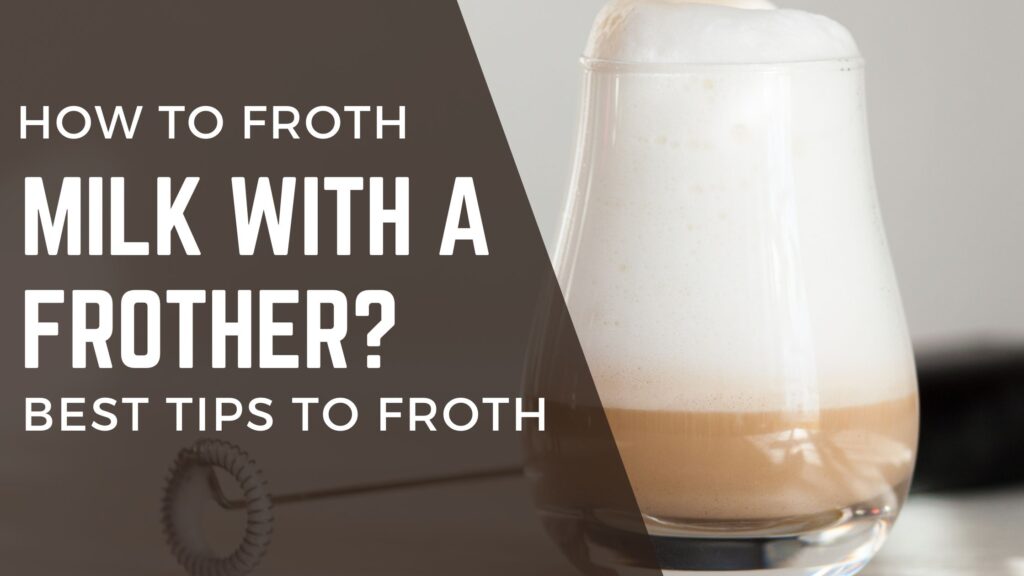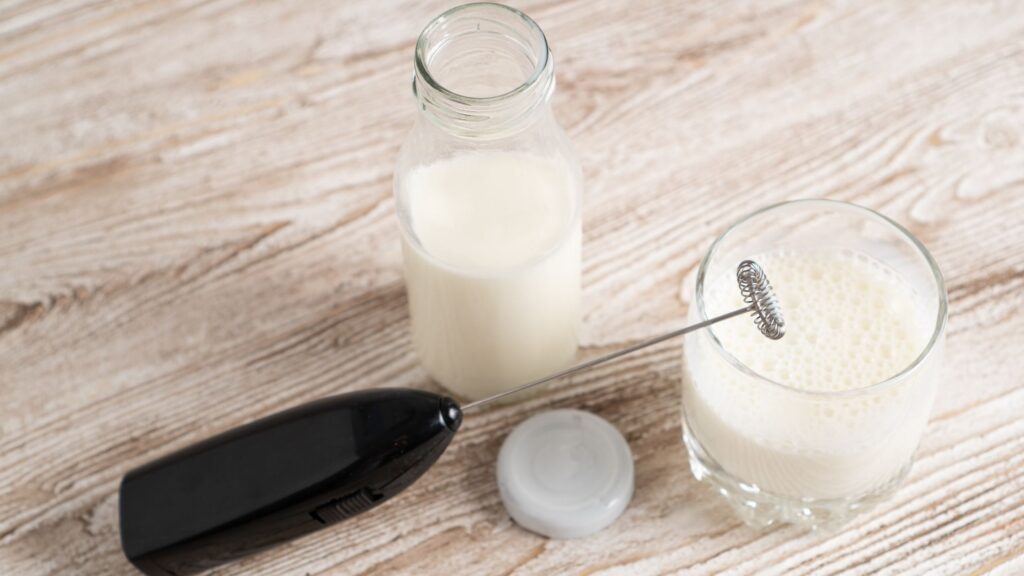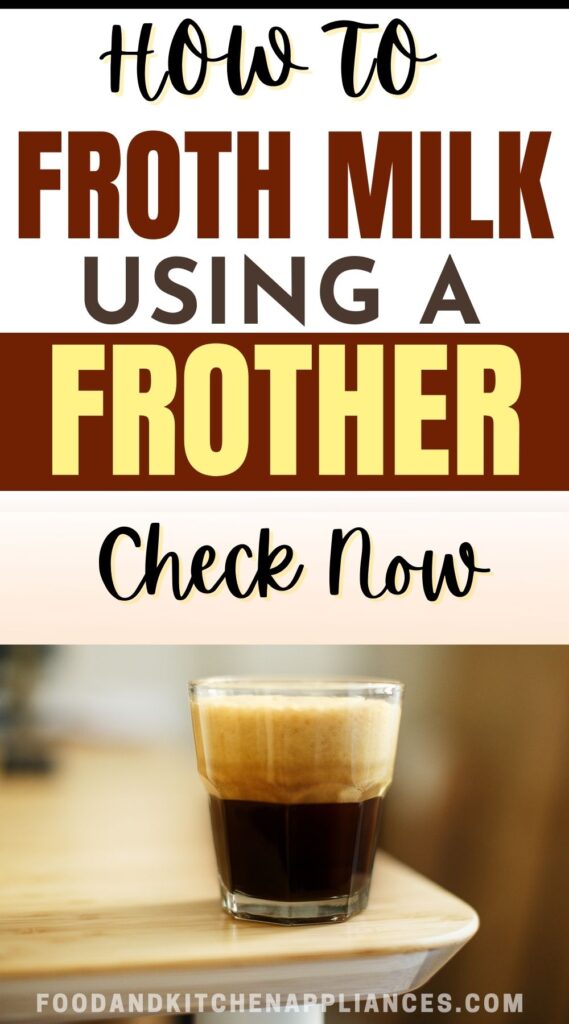Frothing milk is commonly used in coffee and espresso-based beverages to create a creamy, textured foam. It adds a visually appealing element to drinks like cappuccinos, lattes, and macchiatos and can enhance the overall taste and mouthfeel. Let us find out how to froth milk using a frother.

What is a milk frother?
A milk frother is a device used to create frothed or foamed milk for various beverages. It is commonly used in coffee shops and households to prepare drinks like cappuccinos, lattes, and hot chocolates.
A milk frother typically consists of a container or pitcher with a motorized whisk or frothing wand. The whisk is submerged in the milk, and when the motor is activated, it rapidly rotates to create a vortex in the milk, introducing air and causing the milk to foam and increase in volume.
This frothed milk can then be poured onto coffee or other beverages to create a creamy, textured layer on top.
There are different types of milk frothers available. Some frothers are handheld and require manual operation, while others are electric and offer automated frothing.
Electric milk frothers often have additional features like adjustable temperature settings and frothing options for different types of milk, such as whole milk, skim milk, or plant-based milk alternatives.
How to froth milk using a milk frother?
To froth milk using a frother, you can follow these steps:
Start by choosing a frother
There are various types available, including handheld frothers and electric frothers. Make sure you have the appropriate frother for your needs.
Pour milk into microwave safe container
Pour the desired amount of milk into a microwave-safe container or a milk frothing pitcher. It’s important not to fill it more than halfway to allow room for the froth to expand.
If you’re using a handheld frother, immerse the frother’s whisk or wand into the milk. If you’re using an electric frother, pour the milk into the frother’s container as per the manufacturer’s instructions.
Start frothing
Turn on the frother or activate the whisk, submerging it in the milk. Move the frother or whisk up-and-down or circular motion to create foam.
The process may take a few minutes, depending on the type of frother you’re using.
Check milk temeprature
Pay attention to the milk’s temperature while frothing. If you desire warm-frothed milk, use preheated milk or heat the milk in the microwave or stovetop before frothing. If using a microwave, heat in short intervals, stirring in between, to prevent overheating.
Once you have achieved the desired froth consistency and temperature, turn off the frother or remove the whisk from the milk.
Tap the container on a countertop or table to remove large air bubbles and froth.
Add milk to your coffee
Now, you can use the frothed milk to make lattes, cappuccinos, hot chocolates, or any other beverage you choose. Pour the frothed milk into your prepared coffee or drink and enjoy.
PRO TIP: consult the instructions provided with your specific frother, as different models may have slight variations in usage.

How to properly froth milk in a frother?
Frothing milk is required to produce a creamy cup of joe.
Choose the Right Milk
Whole milk is typically the best for frothing due to its higher fat content, which helps create a smoother and more stable foam. However, you can also use skim, soy, almond, or other non-dairy alternatives. Keep in mind that different types of milk may produce varying results.
Select a Frothing Method
Depending on your available equipment, there are a few ways to froth milk. Here are three standard methods:
Manual Frothing
This method involves using a handheld milk frother or a French press. With a handheld frother, you can heat the milk separately and then froth it by immersing the frother’s whisk into the milk and turning it on. A French press can be used by heating the milk separately, pouring it into the press, and rapidly moving the plunger up and down to create foam.
Steam Wand
This method is ideal if you have an espresso machine with a steam wand. Fill a small stainless steel pitcher with cold milk, ensuring not to fill it more than halfway.
Submerge the steam wand tip just below the surface of the milk, open the steam valve, and position the pitcher at an angle.
Allow the steam to circulate and create a whirlpool effect by slightly tilting the pitcher. This technique will create microfoam, which is a velvety texture with tiny bubbles.
Electric Frother
Electric milk frothers are standalone devices explicitly designed for frothing milk. They usually consist of a base, a detachable milk pitcher, and a frothing whisk.
Pour cold milk into the pitcher (do not exceed the maximum fill line), attach the frothing whisk, place the pitcher on the base, and select the frothing option. The machine will heat and froth the milk simultaneously.
Frothing Technique
Regardless of the method you choose, there are a few key techniques to keep in mind:
Start with cold milk
Cold milk froths better than warm milk. Using fresh, cold milk straight from the refrigerator will yield better results.
Control the depth
When frothing with a handheld frother or a steam wand, keep the frothing whisk or the steam wand tip just below the surface of the milk. This allows air to be incorporated into the milk, creating foam.
Maintain consistent motion
Whether using a handheld frother, a French press, or a steam wand, maintain a consistent motion while frothing. Move the frothing whisk or steam wand in an up-and-down or circular motion to ensure even frothing and texture.
Stop at the right time
Pay attention to the temperature and visual cues when frothing. The milk should reach a temperature of around 150-160°F (65-70°C) for a hot beverage. As the milk expands during frothing, be careful not to overfill the container.
Pour and Enjoy
After achieving the desired froth, carefully pour the milk into your prepared coffee or espresso. Tilt the pitcher slightly to let the milk flow first, then pour the foam on top.
Remember, frothing milk takes practice, and the results may vary depending on factors like milk type, equipment, and technique. With time and experience, you can create beautifully frothed milk for your favorite hot beverages.

How long to froth milk with a frother?
The time required to froth milk can vary depending on your method and equipment. Here are some general guidelines:
Steam Wand (Espresso Machine)
If you’re using a steam wand on an espresso machine, the frothing process typically takes around 20 to 30 seconds.
Start with the steam wand submerged just below the surface of the milk and gradually raise it as the milk expands and creates foam. The ideal temperature for frothed milk is around 150 to 155°F (65 to 68°C).
Handheld Milk Frother
If you’re using a handheld milk frother, it usually takes 30 to 60 seconds to froth it.
Place the frother’s whisk just below the surface of the milk and turn it on. Move the frother up and down to create the desired amount of froth.
Manual Frothing
You can achieve frothy milk by vigorously whisking it in a saucepan over medium heat if you prefer manual frothing.
This method may take a bit longer, around 1 to 2 minutes, as you need to whisk the milk until it creates enough foam.
Remember, these are just general guidelines, and the time required may vary depending on the amount of milk you’re frothing, the type of milk used (whole milk froths better than skim milk), and personal preference regarding the level of frothiness.
It’s best to experiment and adjust the technique and duration based on your desired results.
Frequently asked questions
Can you froth cold milk?
Yes, it is possible to froth cold milk. Frothing milk involves incorporating air into it, creating a creamy and frothy texture. While traditionally, frothing is done with hot milk, there are methods to froth cold milk as well.
How to froth milk perfectly?
To froth, milk perfectly, choose the right milk. Whole milk is typically the best option for frothing because it has a higher fat content, which helps create a creamy texture and stable foam.
However, you can also use other types of milk, like 2% or skim milk, but the results may not be as creamy.
Do you have to steam milk to froth it?
No, you don’t necessarily have to steam milk to froth it. While steaming milk is a standard method used to create froth for beverages like cappuccinos and lattes, there are alternative ways to froth milk without steaming it.
Methods like Whisking, French Press, and Electric Frother don’t need steam to produce steam. You need milk to produce froth, not steam. However, steam makes it easy to produce the froth.
How to use coffee pods without the machine?
Does cinnamon dissolve in coffee? How to add cinnamon to coffee?
How to prepare ground coffee at home?
Is French Press Coffee Stronger Than Drip? A Fact-Based Comparison